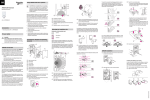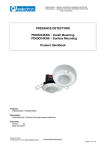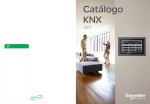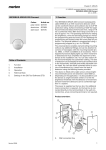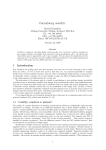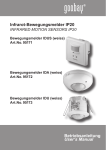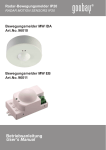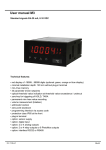Download Argus A2 Operating instructions
Transcript
Using ARGUS with alarm systems KNX ARGUS 220 Operating instructions Art. no. MTN6325.. | Movement detectors are not suitable for use as components of an alarm system. | Movement detectors can trigger false alarms if the installation site has been chosen unfavourably. Movement detectors switch on as soon as they detect a moving heat source. This can be a person, but also animals, trees, cars or differences in temperature in windows. In order to avoid false alarms, the chosen installation site should be such that undesired heat sources cannot be detected. Undesired sources of heat could include the following: • moving trees, shrubbery etc. with a temperature that differs from that of their surroundings. • windows where the influence of sunlight and clouds could cause rapid changes in temperature. Accessories • larger heat sources (e.g. cars), that are detected through windows. – Mounting bracket (Art. no. MTN565291) • insects moving across the lens. – Programming magnet for EMO valve drive (Art. no. MTN639190) • small animals. • rooms flooded with light where the light is reflected on objects (e.g. the floor), which can be the cause of rapid changes in temperature. For your safety ¼ DANGER Risk of fatal injury from electrical current. All work carried out on the unit may only be performed by skilled electricians. Observe the regulations valid in the country of use, as well as the valid KNX guidelines. The ARGUS 220 (subsequently called ARGUS) is a KNX movement detector which can be used both indoors and outdoors due to its IP 55 protection rating. Surface monitoring of 220° for larger house fronts and areas of the house (max. range of 16 m) is combined with a 360° short-range zone with a radius of approx. 4 m. The operating elements for setting the brightness, time and sensitivity (range) as well as the programming area and a red LED for displaying the programming are located under the cover plate for protection. The physical address is programmed using a programming magnet (e.g. art. no. MTN639190). The ARGUS can be mounted on the wall or ceiling and also on to corners or fixed pipes with the mounting bracket (art. no. MTN5652 ..) which is available as an accessory. B G F ∞ C E D D A Sensitivity controller D Select a mounting height between 2 m and 3 m. For optimum monitoring, we recommend a height of 2.5 m on a solid and even base. B Time controller C Brightness controller D Functional display, lights up each time movement is detected E Brightness sensor F Programming area for magnet G Programming LED Selecting the installation site Explanation of the symbols used 3 Feed in the bus line. – To feed the bus line into the back of the device from above, attach the spacers supplied to the wall connection box. To avoid the connected load being switched on due to environmental influences, the ARGUS should be installed so that it is protected against rain and direct sunlight. A raindrop running over the lens, for example, can activate the movement detector. E E CAUTION The device can become damaged. If installation is not carried out correctly, water can penetrate the movement detector and damage it. Always mount it with the spherical head pointing downwards. – Feeding in the bus line from behind: slide the rubber grommet A supplied over the stripped bus line. E Maintain a distance of at least 5 m from sources of optical interference. Use the masking segments provided if necessary. – Feeding in the bus line from below: cut the rubber insert B supplied according to the cable thickness. Insert the rubber insert into the wall connection box. Push the bus line through. In principle, you should not mount the luminaire underneath the ARGUS. The radiated heat from the luminaire can influence the function of the movement detector and lead to a permanent lighting circuit under certain conditions. A OK OK Correct Connections, displays and operating elements Not optimal F Incorrect A B C H ARGUS introduction ½ A G B When selecting a suitable installation site, you should take a number of factors into account so that the movement detector operates optimally. The following diagram shows the ranges of the ARGUS. They are based on average temperature conditions at a mounting height of 2.5 m. The range of a movement detector can fluctuate considerably at variable temperatures. F A minimum distance of 5 m should be maintained between the luminaire and the movement detector. If this distance cannot be achieved, you can use the segments provided to "mask" the light source from the area of detection. If you wish to attach several movement detectors, install them so that the detection areas of the individual movement detectors intersect each other. 4 Mount the wall connection box. If possible, install the movement detector sideways to the direction of movement. m F E 2,5 D 0 A Wall connection box 12 B Top section 10 C Cover plate 8 0,8 m 4 0 2 4 6 14 8 B A 10 12 14 16 m C OK 6 D Sensor head ARGUS installation 1 Undo both screws and remove the wall connection box from the device. 4 E Contact pins F Cable routing for bus line from underneath 2 0 G Cable routing for bus line from behind 2 H Terminal block for connecting the bus line and for locating the contact pins 6 The integrated functional display lights up when movement is detected and thus simplifies the alignment of the device at the installation site. You can also optionally switch off the functional display via a parameter setting. In order to install the ARGUS on the ceiling, you must rotate the sensor head. Change the direction of rotation once you have reached the end stops. 1 Turn the sensor head upwards as far as it will go. OK 4 Installing the ARGUS on the ceiling 2 Turn the sensor head clockwise as far as it will go. 3 Align the sensor head. 8 10 12 14 4 2 0 2 4 6 8 10 12 14 16 m The area of detection can be adapted to the local conditions due to the horizontally, vertically and axially adjustable sensor head. You can also block unwanted zones or sources of interference (e.g. trees) from the area of detection using the masking segments provided. A Inner security zone with an angle of detection of 360° and a radius of approx. 4 m. The device is fitted with a light sensor whose brightness threshold can be set from approx. 3 to 1000 lux. Depending on the application, it is also possible to use the device as a light-sensitive switch or to link the brightness threshold with the detection of movement. Several movement detectors can be combined together in a system. C Outer security zone with an angle of detection of 220° and a detection area of approx. 16 m x 28 m. OK 2 Mark drill holes on the mounting surface. B Central security zone with an angle of detection of 220° and an area of detection of approx. 9 m x 18 m. The power is supplied via the bus line. No additional mains connection is required. As the bus line is connected directly to the terminal block in the wall connection box, a bus connecting terminal is not required. 1 1 2 3 Bus V6325-561-00 03/08 GB Using ARGUS with alarm systems KNX ARGUS 220 Operating instructions Art. no. MTN6325.. | Movement detectors are not suitable for use as components of an alarm system. | Movement detectors can trigger false alarms if the installation site has been chosen unfavourably. Movement detectors switch on as soon as they detect a moving heat source. This can be a person, but also animals, trees, cars or differences in temperature in windows. In order to avoid false alarms, the chosen installation site should be such that undesired heat sources cannot be detected. Undesired sources of heat could include the following: • moving trees, shrubbery etc. with a temperature that differs from that of their surroundings. • windows where the influence of sunlight and clouds could cause rapid changes in temperature. Accessories • larger heat sources (e.g. cars), that are detected through windows. – Mounting bracket (Art. no. MTN565291) • insects moving across the lens. – Programming magnet for EMO valve drive (Art. no. MTN639190) • small animals. • rooms flooded with light where the light is reflected on objects (e.g. the floor), which can be the cause of rapid changes in temperature. For your safety ¼ DANGER Risk of fatal injury from electrical current. All work carried out on the unit may only be performed by skilled electricians. Observe the regulations valid in the country of use, as well as the valid KNX guidelines. The ARGUS 220 (subsequently called ARGUS) is a KNX movement detector which can be used both indoors and outdoors due to its IP 55 protection rating. Surface monitoring of 220° for larger house fronts and areas of the house (max. range of 16 m) is combined with a 360° short-range zone with a radius of approx. 4 m. The operating elements for setting the brightness, time and sensitivity (range) as well as the programming area and a red LED for displaying the programming are located under the cover plate for protection. The physical address is programmed using a programming magnet (e.g. art. no. MTN639190). The ARGUS can be mounted on the wall or ceiling and also on to corners or fixed pipes with the mounting bracket (art. no. MTN5652 ..) which is available as an accessory. The integrated functional display lights up when movement is detected and thus simplifies the alignment of the device at the installation site. You can also optionally switch off the functional display via a parameter setting. B G F ∞ C E D D A Sensitivity controller D Select a mounting height between 2 m and 3 m. For optimum monitoring, we recommend a height of 2.5 m on a solid and even base. B Time controller C Brightness controller D Functional display, lights up each time movement is detected E Brightness sensor F Programming area for magnet G Programming LED Selecting the installation site Explanation of the symbols used 3 Feed in the bus line. – To feed the bus line into the back of the device from above, attach the spacers supplied to the wall connection box. To avoid the connected load being switched on due to environmental influences, the ARGUS should be installed so that it is protected against rain and direct sunlight. A raindrop running over the lens, for example, can activate the movement detector. E E CAUTION The device can become damaged. If installation is not carried out correctly, water can penetrate the movement detector and damage it. Always mount it with the spherical head pointing downwards. – Feeding in the bus line from behind: slide the rubber grommet A supplied over the stripped bus line. E Maintain a distance of at least 5 m from sources of optical interference. Use the masking segments provided if necessary. – Feeding in the bus line from below: cut the rubber insert B supplied according to the cable thickness. Insert the rubber insert into the wall connection box. Push the bus line through. In principle, you should not mount the luminaire underneath the ARGUS. The radiated heat from the luminaire can influence the function of the movement detector and lead to a permanent lighting circuit under certain conditions. A OK OK Correct Connections, displays and operating elements Not optimal F Incorrect A B C H ARGUS introduction ½ A G B When selecting a suitable installation site, you should take a number of factors into account so that the movement detector operates optimally. The following diagram shows the ranges of the ARGUS. They are based on average temperature conditions at a mounting height of 2.5 m. The range of a movement detector can fluctuate considerably at variable temperatures. F A minimum distance of 5 m should be maintained between the luminaire and the movement detector. If this distance cannot be achieved, you can use the segments provided to "mask" the light source from the area of detection. If you wish to attach several movement detectors, install them so that the detection areas of the individual movement detectors intersect each other. 4 Mount the wall connection box. If possible, install the movement detector sideways to the direction of movement. m F E 2,5 D 0 A Wall connection box 12 B Top section 10 C Cover plate 8 D Sensor head E Contact pins F Cable routing for bus line from underneath 0,8 m 4 0 2 4 6 14 8 B A 10 12 14 16 m C OK ARGUS installation 1 Undo both screws and remove the wall connection box from the device. 6 4 2 0 G Cable routing for bus line from behind 2 H Terminal block for connecting the bus line and for locating the contact pins 6 In order to install the ARGUS on the ceiling, you must rotate the sensor head. Change the direction of rotation once you have reached the end stops. 1 Turn the sensor head upwards as far as it will go. OK 4 Installing the ARGUS on the ceiling 2 Turn the sensor head clockwise as far as it will go. 3 Align the sensor head. 8 10 12 14 4 2 0 2 4 6 8 10 12 14 16 m The area of detection can be adapted to the local conditions due to the horizontally, vertically and axially adjustable sensor head. You can also block unwanted zones or sources of interference (e.g. trees) from the area of detection using the masking segments provided. A Inner security zone with an angle of detection of 360° and a radius of approx. 4 m. The device is fitted with a light sensor whose brightness threshold can be set from approx. 3 to 1000 lux. Depending on the application, it is also possible to use the device as a light-sensitive switch or to link the brightness threshold with the detection of movement. Several movement detectors can be combined together in a system. C Outer security zone with an angle of detection of 220° and a detection area of approx. 16 m x 28 m. OK 2 Mark drill holes on the mounting surface. B Central security zone with an angle of detection of 220° and an area of detection of approx. 9 m x 18 m. 1 2 3 Bus The power is supplied via the bus line. No additional mains connection is required. As the bus line is connected directly to the terminal block in the wall connection box, a bus connecting terminal is not required. 2 V6325-561-00 03/08 GB Setting the sensitivity Putting ARGUS into operation ½ | CAUTION If not installed correctly, the device can be damaged by condensation. In the case of sloping ceilings, install the device so that spherical head is pointing down and always at an angle of 15° - 90°. When the spherical head points downwards, any water from condensation could run down the device. The ARGUS operating elements are protected under a cover plate. The arrow's position on the controllers shows you the set values. 1 Push up the cover plate until you feel it hit the stop (approx. 5 mm) and pull it off. Type of protection IP 55 cannot be guaranteed if the mounting bracket is not 15° - 90°. 15° - 90° Setting the brightness threshold 2 Guide a programming magnet (e.g. art. no. MTN639190) over the programming area. The programming LED lights up. 3 Load the physical address and application into the device from the ETS. The programming LED goes out when the application has been loaded successfully. This device is ready for operation. Installing the ARGUS on corners and fixed pipes You can attach the ARGUS to inner/outer corners or fixed pipes using the Merten mounting bracket (art. no. MTN5652..). You can feed the bus line to the device from behind through the mounting bracket. The brightness sensor must not be covered up. KNX +- 3 LUX 1000 LUX ∞ 2 Set the brightness controller to daytime operation (infinity symbol/right-hand stop) or select the setting "independent of brightness" in ETS. ½ CAUTION The device could become damaged. The sensor head should only be rotated until it reaches the stop and no further. To achieve an angle "above" the stop, change the direction of rotation. 1 Align the sensor head in the direction of the area that is to be monitored. Setting the time This makes it possible to set the overshoot time of the connected loads. This is the time period from the last detected movement until the load is switched off. Depending on the ETS application, the overshoot time is either set in the ETS program (infinitely variable between 3 seconds and 152 hours) or directly on the ARGUS (six steps of approx. 1 second to approx. 8 minutes). | Once the load has been switched on, the set brightness threshold is ignored. Depending on the settings in ETS, each registered movement can reset the overshoot time. If the movement detector no longer switches off, it is probably because it is continually detecting new movement and is thus always extending the overshoot time. 9° 24° 12° 12° 12° Nominal voltage: KNX connection: Power consumption: Angle of detection: Range: Number of levels: Number of zones: Minimum mounting height: Recommended mounting height: Sensitivity: Light sensor: Time: Programming: Display elements: DC 24 V (+6 V / -4 V) via terminal block approx. 7 mA 220° max. 16 m 7 112 with 448 switching segments 1.7 m 2.5 m infinitely adjustable externally infinitely adjustable externally, from approx. 3 lux to approx. 1000 lux infinitely adjustable in the software from 3 seconds to 152 hours or adjustable externally in 6 steps from approx. 1 second to approx. 8 minutes. magnet-sensitive sensor for assigning the physical address. 1 red LED: Programming check, 1 red LED: Functional display Possible settings for the sensor head: Wall mounting: 9° up, 24° down, 12° left/right, ± 12° axial Ceiling mounting: 4° up, 29° down, 25° left/right, ± 8.5° axial Type of protection: IP 55 at an angle of inclination from 15° to 90° Ambient temperature: -25 °C to +55 °C EC guidelines: Low Voltage guideline 73/23/ EEC, EMC guideline 89/336/EEC Initialisation: Due to the limitation of the telegram rate, a telegram cannot be generated until at least 17 s after the initialisation. Schneider Electric Industries SAS If you have technical questions, please contact the Customer Care Center in your country. www.schneider-electric.com Blocking out individual areas Using the four segments supplied, you can block out unwanted zones and sources of interference from the area of detection. You can wire the bus line through the two terminals (+) and (–) without encountering problems. Technical data – Sun symbol: The ARGUS detects movements up to approx. 1000 lux. Depending on the application program, you can either set the time in the software or on the device. Setting ARGUS 14 mm – Moon symbol (left stop) The ARGUS will only detect movements during the hours of darkness (approx. 3 lux). 1 Set the time controller to 1 second (left-hand stop). The functional display lights up each time movement is detected. Connecting KNX Here you can infinitely set the ambient brightness level at which the ARGUS detects movements and triggers a switching procedure. – Infinity symbol (right-hand stop): The ARGUS detects movements regardless of the ambient brightness. Conducting a functional test 3 Set the sensitivity controller to maximum (righthand stop). | Here you can infinitely set the distance up to which ARGUS detects movements (any distance up to max. 16 m). This product must be installed, connected and used in compliance with prevailing standards and/or installation regulations. As standards, specifications and designs develop from time to time, always ask for confirmation of the information given in this publication. A 12° Installation of the top section of the ARGUS 1 Place the top section on the wall connection box from the front. 2 Fasten the top section with the screws provided. The electrical connection from the terminal box to the contact pins is established automatically when the screws are tightened. 3 Position the cover plate at the markings on the side, and guide it upwards. 1 2 25° 25° 8,5° 8,5° 2 From its edge step into the area of detection to see whether the ARGUS switches the load and the functional display as required. | Ensure that the brightness sensor A is not covered, as the sensitivity to light is otherwise reduced. 3 3 V6325-561-00 03/08 2 1 4° 29° Setting the sensitivity Putting ARGUS into operation ½ | CAUTION If not installed correctly, the device can be damaged by condensation. In the case of sloping ceilings, install the device so that spherical head is pointing down and always at an angle of 15° - 90°. When the spherical head points downwards, any water from condensation could run down the device. The ARGUS operating elements are protected under a cover plate. The arrow's position on the controllers shows you the set values. 1 Push up the cover plate until you feel it hit the stop (approx. 5 mm) and pull it off. Type of protection IP 55 cannot be guaranteed if the mounting bracket is not 15° - 90°. 15° - 90° Setting the brightness threshold 2 Guide a programming magnet (e.g. art. no. MTN639190) over the programming area. The programming LED lights up. 3 Load the physical address and application into the device from the ETS. The programming LED goes out when the application has been loaded successfully. This device is ready for operation. Installing the ARGUS on corners and fixed pipes You can attach the ARGUS to inner/outer corners or fixed pipes using the Merten mounting bracket (art. no. MTN5652..). You can feed the bus line to the device from behind through the mounting bracket. The brightness sensor must not be covered up. KNX +- 3 LUX 1000 LUX ∞ 2 Set the brightness controller to daytime operation (infinity symbol/right-hand stop) or select the setting "independent of brightness" in ETS. ½ CAUTION The device could become damaged. The sensor head should only be rotated until it reaches the stop and no further. To achieve an angle "above" the stop, change the direction of rotation. 1 Align the sensor head in the direction of the area that is to be monitored. Technical data Nominal voltage: KNX connection: Power consumption: Angle of detection: Range: Number of levels: Number of zones: Minimum mounting height: Recommended mounting height: Sensitivity: Light sensor: Time: – Sun symbol: The ARGUS detects movements up to approx. 1000 lux. Depending on the application program, you can either set the time in the software or on the device. Setting ARGUS 14 mm – Moon symbol (left stop) The ARGUS will only detect movements during the hours of darkness (approx. 3 lux). 1 Set the time controller to 1 second (left-hand stop). The functional display lights up each time movement is detected. Connecting KNX Here you can infinitely set the ambient brightness level at which the ARGUS detects movements and triggers a switching procedure. – Infinity symbol (right-hand stop): The ARGUS detects movements regardless of the ambient brightness. Conducting a functional test 3 Set the sensitivity controller to maximum (righthand stop). | Here you can infinitely set the distance up to which ARGUS detects movements (any distance up to max. 16 m). Setting the time This makes it possible to set the overshoot time of the connected loads. This is the time period from the last detected movement until the load is switched off. Depending on the ETS application, the overshoot time is either set in the ETS program (infinitely variable between 3 seconds and 152 hours) or directly on the ARGUS (six steps of approx. 1 second to approx. 8 minutes). | Once the load has been switched on, the set brightness threshold is ignored. Depending on the settings in ETS, each registered movement can reset the overshoot time. If the movement detector no longer switches off, it is probably because it is continually detecting new movement and is thus always extending the overshoot time. Programming: Display elements: DC 24 V (+6 V / -4 V) via terminal block approx. 7 mA 220° max. 16 m 7 112 with 448 switching segments 1.7 m 2.5 m infinitely adjustable externally infinitely adjustable externally, from approx. 3 lux to approx. 1000 lux infinitely adjustable in the software from 3 seconds to 152 hours or adjustable externally in 6 steps from approx. 1 second to approx. 8 minutes. magnet-sensitive sensor for assigning the physical address. 1 red LED: Programming check, 1 red LED: Functional display Possible settings for the sensor head: Wall mounting: 9° up, 24° down, 12° left/right, ± 12° axial Ceiling mounting: 4° up, 29° down, 25° left/right, ± 8.5° axial Type of protection: IP 55 at an angle of inclination from 15° to 90° Ambient temperature: -25 °C to +55 °C EC guidelines: Low Voltage guideline 73/23/ EEC, EMC guideline 89/336/EEC Initialisation: Due to the limitation of the telegram rate, a telegram cannot be generated until at least 17 s after the initialisation. Blocking out individual areas Using the four segments supplied, you can block out unwanted zones and sources of interference from the area of detection. You can wire the bus line through the two terminals (+) and (–) without encountering problems. 9° 24° 12° 12° 12° A 12° Installation of the top section of the ARGUS 1 Place the top section on the wall connection box from the front. The electrical connection from the terminal box to the contact pins is established automatically when the screws are tightened. 3 Position the cover plate at the markings on the side, and guide it upwards. 1 2 1 2 4° 29° 25° 25° 8,5° 8,5° 2 From its edge step into the area of detection to see whether the ARGUS switches the load and the functional display as required. Schneider Electric Industries SAS | Ensure that the brightness sensor A is not covered, as the sensitivity to light is otherwise reduced. If you have technical questions, please contact the Customer Care Center in your country. www.schneider-electric.com This product must be installed, connected and used in compliance with prevailing standards and/or installation regulations. As standards, specifications and designs develop from time to time, always ask for confirmation of the information given in this publication. 3 4 V6325-561-00 03/08 2 Fasten the top section with the screws provided. suit requirements. Check the "Brightness" and "Times" tabs. In this way the corresponding objects are connected to a KNX switch actuator. Movement/monitoring 1307/1.0 ● General In the following the device will be referred to as the movement detector. The movement block will only switch off when there is no more movement in front of the device - in other words, independently of the brightness. The ETS application includes 5 independent movement blocks, each with 4 output objects. | Switch Actuator Status feedback obj. Safety pause Note: All of the settings described refer to ETS version 3, but you can also use all the settings and functions with ETS version 2. The application files (vd2 and vd3) are configured in such a way that the application loading time is considerably reduced. When you convert an ETS 2 project to ETS 3, you lose this time saving. If you are working with ETS 3, use the vd3 files. Total possible addresses and connections: 254 addresses; 255 connections 1/1/2 Status feedback obj. To familiarise yourself with the extended and more complex parameters see the following pages. ● General functions The common safety pause The application has a common safety pause system in other words, a safety pause triggered by the movement detector will affect all blocks in the application. As specified in a parameter the safety pause can be triggered at the status feedback object (safety pause) when there is an OFF telegram or when there is an OFF and ON telegram. The status feedback object of the switching/dimming actuator must be connected to the feedback safety pause object of the movement detector. Once a safety pause has been started, signals from the movement sensor will no longer be evaluated for this period of time. An elapsed staircase timer cannot be started by a movement during an active safety pause and an ongoing staircase timer cannot be retriggered by a movement. An ongoing staircase timer is not affected by a safety pause being activated. In other words, the staircase timer will run through in the usual way. Note: ETS 2 or ETS 3 (by clicking "Standard"), all the values that you have changed so far will be deleted. Any group addresses which have been parametrised will be lost. Note: Due to the fact that various functions depend on other functions, these dependent functions will not be visible and selectable in the ETS unless the preceding function has been enabled. If you de-select functions or change parameters, group addresses that have already been connected may be removed. ● Getting started quickly | Optical feedback can only be avoided by Note: When you insert the application in the ETS or click on the "Standard" button, the ETS application will switch automatically to minimum configuration. In minimum configuration, it is possible to put the presence detector into operation. For some application cases, the minimum configuration is even adequate for practical use. We also recommend opening minimum configuration as a way of familiarising yourself with the application software for the presence detector. Here all of the extended or more complex parameters are disabled. In "Block configuration" only the first "Movement" block is enabled for use. In the "Telegrams" tab only output object 1 is enabled. This is a 1-bit output object. At the start of movement this object sends a 1 telegram and when the internal staircase timer has elapsed it sends a 0 telegram. Each parameter can always be tuned to its individual requirements. The brightness threshold and the staircase timer always need to be adjusted to © 2008 Schneider Electric Switch object Movement Detector | If you switch back to the preset values in either | 1/1/1 Switch object selecting the right installation location for the movement detector and the lighting. The safety pause system and the safety pause object of the application cannot compensate for all planning mistakes. Communication objects You can select the following communication objects: General: 5 Function Object name Type Prio Flags Behaviour Safety pause Status feedback object 1 bit Low WC Receive an ON telegram to the bus. When no further movement is detected the staircase timer starts. An OFF telegram is transmitted to the bus after a parametrised time. Brightness is measured only at the moment when the first movement is detected. If further movement is detected, an OFF telegram is not transmitted, irrespective of brightness changes. The staircase timer starts only when movement is no longer detected, and an OFF telegram is transmitted after the parametrised time period. Parameter | The parameter settings include various Note: functions which depend on other functions. Depending on the parameter setting, some functions or objects may or may not be displayed in the ETS. General Parameter Setting Safety pause via status feedback Disabled object For OFF telegram Block configuration For ON and OFF telegram Safety pause (1 - 20) seconds Up to five movement blocks are available. In the default setting, block 1 is enabled. 1-20, preset: 2 ● General brightness evaluation: Parameter The current brightness can be determined by the internal brightness sensor, by an external communication object or by both dependencies. The relationship between internal and external values can be parametrised while doing this. Block configuration Parameter Setting Movement block X Enabled Disabled Communication objects Movement detection You can select the following communication objects: The device has a detection angle of 220°. General: To suppress disturbance variables or if delayed activation is required, a dead time for the start of movement can be activated. The dead time is started after movement has been detected (start of movement). The start of movement action (transmitting a telegram to the bus) can take place if a movement is still detected within the movement time after the dead time has elapsed. Function Object name Type Prio Flags Behaviour External sensor Actual value input 2 bytes Low WCT Transmit/ U receive/ update Parameter From internal sensor From object, actual value input From internal sensor and object 0% - 100%, in 5% steps; preconfiguration 50% Movement Taking the separately measured lux value (0% - 100%) into account For actual value correction you will need a luxmeter. The measured values are then input into the application software of the presence detector. When intense sunlight is shining onto the reference area or the installation location, the measurements should not be taken. Under certain circumstances darkening the room may improve the measurement results. Dead Time Movement Time Movement Time Movement Time Dead Movement Time Time OFF Setting Actual value (brightness) ON Parameter Switch object General Time Time ● Movement block In master mode or normal mode the movement time corresponds to the staircase timer in the diagram above. In slave mode or monitoring mode the movement time corresponds to the cycle time. In practice a large number of applications can be implemented by means of the various blocks. Basic function of a movement block Block diagram of movement block A staircase timer is "integrated" into a movement block. When the ambient brightness is too low and a movement is detected, the movement block transmits A block diagram clarifies the relationships between the individual dependencies. © 2008 Schneider Electric 6 Communication objects Move Sensor You can select the following communication objects: Movement detection Master Trigger Block X, general movement sensors: Brightness sensor Brightness obj. Brightness evaluation Function Object name Type Block X Range 1 byte Low Prio Flags Behaviour WC Receive Parameter Alwaysdark obj. Times Telegrams Note: | The parameter settings include various Trigger obj. Disable obj. Disable function functions which depend on other functions. Depending on the parameter setting, some functions or objects may or may not be displayed in the ETS. Output obj. 1-4 Movement evaluation Block X, general - movement sensors As has already been stated above, the movement sensor input into movement detection. The master trigger object is brightness-dependent and with an ON telegram simulates a movement; an OFF telegram is ignored. The trigger object is brightness-independent and also simulates a movement for an ON telegram . Whether the trigger object can switch the lighting off early when there is an OFF telegram can be parametrised. Parameter Advanced settings Enabled Disabled The following settings are only visible when "Disabled". Sensitivity (for all sensors) High Medium Low Range adjustable Potentiometer Parameter | The master trigger object and the trigger object Note: Range (only visible by "Parameter") do not appear in the ETS until the device operating mode has been set to "Master mode". See "Block X, general" tab, parameter: "Operating mode". The master/trigger object ignores the dead time (for Dead time, see above) and reacts without a delay. More detailed information about the master/trigger object may be found later on. © 2008 Schneider Electric Setting 10% - 100% (in 10% steps) preconfiguration: 100% The following settings are only visible when "Enabled". Range object (for all sensors) Disabled Enabled Dead time, start of movement (for Disabled all sensors) Enabled 7 Time base 1 min, 1s Time factor (1 - 255) 3, (1-255) Brightness object 1 bit Block X, general movement sensors sector X Parameter Setting Sensitivity High The brightness object sends a 1-bit value on the bus. If the parametrised brightness threshold is not reached, an ON telegram can be transmitted. If the parametrised brightness threshold is exceeded, an OFF telegram can be transmitted. Inverted transmission can also be set. Medium Low Range adjustable Via parameters Via Potentiometer Overwrite range during download Enabled Too bright Brightness threshold Brightness Disabled Range 10% - 100% (in 10% steps) preconfiguration: 100% Change range via object Disabled Too dark t ON ON Enabled OFF Brightness object t ● Brightness evaluation Always-dark object Brightness evaluation of a movement detector: Brightness In the case of an enabled "always-dark object", darkness can be simulated internally in the movement detector depending on the object value. The "alwaysdark object" is used with master/slave circuits. Planning master/slave circuits is described further below. Staircase timer Staircase timer Staircase timer Staircase timer Staircase timer Brightness threshold Time Switch object Movement OFF ON Communication objects You can select the following communication objects: Time Block X, general brightness: Time The movement detector changes to non-brightnessdependent mode once the start of movement action (sending an ON telegram) has been carried out. Here freshly detected movements can retrigger the staircase timer. The movement detector cannot process the brightness jump and there is not even any setting of a hysteresis. Object name Type Prio Flags Behaviour Block X Brightness threshold 2 bytes Low WC Receive Block X Brightness object 1 bit Low CT Transmit Block X Always-dark object Low WC Receive 1 bit Note: | The parameter settings include various functions which depend on other functions. Depending on the parameter setting, some functions or objects may or may not be displayed in the ETS. Brightness The brightness threshold can be parametrised separately for each of the five movement blocks. Each block has its own "Brightness" tab. A staircase timer be started (depending on parametrisation of the device) and an ON telegram transmitted to the bus only after the value is below the parametrised brightness threshold and the movement detector detects a movement. The brightness threshold can be set between 3 and 1000 lux. Via the "Brightness threshold object" "Enabled" or "Disabled" you can select whether the brightness threshold should be changed via the bus. This can be useful when several movement detectors are installed in a building. The brightness threshold can be changed using the "Brightness threshold - Block X" object via the ETS or an IP touch panel, for example. The brightness threshold is set to the same level in all parts of the building. © 2008 Schneider Electric Function 8 Parameter Master mode Block X, general brightness With master mode all of the possible parameters and communication objects of the movement detector are available. A master-slave system can be set up with the aid of the master trigger object or the trigger object. In the default setting, the movement detector transmits an ON telegram at the start of movement and transmits an OFF telegram when the movement time (staircase timer) has expired. Parameter Setting Movement detection is brightness-dependent independent of brightness Brightness threshold adjustable via Parameters Potentiometer Overwrite brightness threshold during download Enabled Slave mode Disabled Brightness threshold (3 - 1000 lux) 3 - 1000 lux; preconfiguration: see "General" tab 130 Brightness threshold object In slave mode the default setting is that ON telegrams are sent cyclically when a movement is detected. These telegrams are intended for the master trigger object or for the trigger object of the master. Disabled Enabled Brightness object 1 bit Do not send Transmit Monitoring mode Transmit inverted Always-dark object (= not brightness-dependent) In monitoring mode the default setting is that ON telegrams are sent cyclically when a movement is detected. At the end of the movement time (cycle time with movement) OFF telegrams are transmitted cyclically. Disabled Enabled Switch on at movment Enabled Disabled Note: | Use the "Monitoring mode" setting when the ● Operating modes movementmovement detector is being used for room monitoring and telegrams are to be sent cyclically on the bus. The operating mode in which this block operates is specified in the application software for each block (movement blocks 1 - 5). The following operating modes are available: – Normal operation – Master mode – Slave mode – Monitoring mode Depending on the operating mode different parameters and communication objects will be displayed. Each operating mode can operate brightness-dependently or non-brightnessdependently. Normal operation In this operating mode the movement detector does not have any external trigger objects (master trigger object, trigger object). Telegrams cannot be sent cyclically and this means a master-slave system cannot be set up. In the default setting, the movement detector transmits an ON telegram at the start of movement and transmits an OFF telegram when the movement time (staircase timer) has expired. Note: | Use the "Normal operation" setting when the movement detector is working for itself alone. In other words, one movement detector is used for each room and it switches one light or one light panel. © 2008 Schneider Electric 9 Master mode: – "Send after staircase timer/remaining time has elapsed" – "Send after staircase timer has elapsed and then cyclically" – "Do not send" Slave mode: – "Do not send" (is permanent setting in the background of the application software, is not displayed in the parameters) Monitoring mode: – "Send at end of cycle time when there is movement and then cyclically" (is permanent setting in the background of the application software, is not displayed in the parameters) Communication objects You can select the following communication objects: Block X, general: Function Object name Type Prio Flags Behaviour Block X Master trigger object 1 bit Low WC Receive Block X Trigger object 1 bit Low WC Receive The objects are only visible in "Master mode" operating mode. Parameter Four output objects are available for each of the five movement blocks and they can be enabled via the application software. A transmission pause between the individual output objects can be set for each block. Block X, general Parameter Setting Operating mode Normal operation Master mode Slave mode Note: | Five movement blocks and four output objects Monitoring mode per movement detector means that 20 switching/value objects in all are available. Note: | When toggling between operating modes the "Brightness" and "Times" tabs change. ● Telegrams For each movement block the "Action at start of movement" can be set as a function of the operating mode. Normal operation: – "Send immediately" – "Do not send" Master mode: – "Send immediately" – "Send immediately and then cyclically" – "Do not send" Slave mode: – "Send immediately and then cyclically" (is permanent setting in the background of the application software, is not displayed in the parameters) Monitoring mode: – "Send immediately and then cyclically" (is permanent setting in the background of the application software, is not displayed in the parameters) The behaviour after the "End of movement time" can also be set as a function of the operating mode. Normal operation: – "Send after staircase timer/remaining time has elapsed" – "Do not send" © 2008 Schneider Electric 10 parameters will not be displayed! The parameter settings include various functions which depend on other functions. Depending on the parameter setting, some functions or objects may or may not be displayed in the ETS. Parameter | The parameter settings include various Note: functions which depend on other functions. Depending on the parameter setting, some functions or objects may or may not be displayed in the ETS. Block X general telegrams output switching/value object X Block X, general telegrams Parameter Setting Action at start of movement Send immediately Parameter Setting Object 1 bit 1 byte 0% - 100% Do not send 1 byte 0 - 255 Send immediately and then cyclically When movement time elapsed 2 bytes Send after staircase timer/ remaining time has elapsed At start of movement Do not send Value Transmits its value ON telegram "Send after staircase timer/ remaining time has elapsed and then cyclically" Output object X (1 - 4) Transmits defined value OFF telegram 0% - 100% 0 - 255 Enabled Disabled When movement time elapsed Transmits defined value Value ON telegram Transmits its value Pause between two telegrams (3 3 - 255; preconfiguration: 5 - 255) x 100 ms OFF telegram Output for switching/value object X 0% - 100% For each output object you can select between a 1-bit, 1-byte (0% - 100%), 1-byte (0 - 255) and 2-byte object. The telegram values should be parametrised for the start of movement and for the end of the movement time. Here an object can transmit its current value or a defined value to the bus. 0 - 255 Note regarding 2-byte parameter settings: | Depending on the setting of the object type value there will be new parameters; depending on the parametrisation the values can be input immediately or are determined via sign x basic value x factor. | The current value can be transmitted by a time Note: switch, for example. During the night a lower byte value is transmitted to the output object of the movement detector than in daytime hours. Communication objects You can select the following communication objects: Block X general - telegrams - output for switching/ value object X: Function Object name Type Prio Flags Behaviour Block X Switch object X 1 bit Low WCT Transmit/ receive Block X Value object X 1 byte Low WCT Transmit/ receive Block X Value object X 2 bytes WCT Transmit/ receive Low Parameter | The parameter settings shown below are Note: dependent on the operating mode and the object settings (1 bit, 1 byte or 2 bytes). Depending on the parametrisation some © 2008 Schneider Electric 11 ● Staircase timer Parameter Operating mode: Normal operation The staircase timer or cycle time can be parametrised via a time base x factor. With "Normal operation" and "Master mode" operating modes the "Staircase timer" is parametrised. With "Slave mode" and "Monitoring mode" operating modes the "Cycle time" is parametrised. | The parameter settings include various Note: functions which depend on other functions. Depending on the parameter setting, some functions or objects may or may not be displayed in the ETS. The "Times" tab has some parameter displays | and selectable objects which are dependent on Block X, general times the operating mode set. | Note: In "Slave mode" and "Monitoring mode" operating modes no further objects are displayed by modification on the "Times" tab. Parameter Setting Via movement, time is Retriggerable Not retriggerable Staircase timer adjustable via Parameters Potentiometer Overwriting staircase timer during download Enabled Self-adjusting staircase timer Disabled Self-adjusting staircase timer (always retriggerable) The movementmovement detector is equipped with a "Self-adjusting staircase timer". When the "Selfadjusting staircase timer" is enabled, the movement detector can start a brief overshoot time when someone is in the room for a short time. If they remain in the room longer, a long overshoot time is started. The parameters "Time base", "Minimum time factor", "Time factor for learning step", "Maximum time factor" and "Sensitivity of the learning step" are available for the "Self-adjusting staircase timer." If there is only a brief movement in front of the movement detector, the overshoot time (until switch-off) will be close to the "Minimum time factor" x "Time basis". If movements last longer, a "Time factor for learning step" will be added to the staircase timer up to the maximum, depending on what learning sensitivity has been set. Once the time set on the staircase timer has elapsed, a restart takes place with "Minimum time factor". Disabled Enabled The following settings are only visible when "Self-adjusting staircase timer" is "disabled". Time factor staircase timer object Disabled Enabled Time base, staircase timer 1 min 1s 1 hr Time factor for staircase timer (1 - 1 - 255; preconfiguration: 25 255) The following settings are only visible when "Self-adjusting staircase timer" is "enabled". Minimum time factor (1 - 255) Staircase timer 1 - 255; preconfiguration: 5 Time factor for learning step (1 255) Staircase timer 1 - 255; preconfiguration: 1 Maximum time factor (1 - 255) Staircase timer 1 - 255; preconfiguration: 25 Operating mode: Normal operation You can select the following communication objects: Sensitivity of learning step 1 - 5; preconfiguration: 4 1 = slow 5 = sensitive Block X, general times: Communication objects Communication objects Function Object name Type Prio Block X Time factor, staircase timer 1 byte Low Operating mode: Master mode You can select the following communication objects: Flags Behaviour WC Transmit Block X, general times: Function Object name Type Prio Flags Behaviour Block X Master trigger object 1 bit Low WC Transmit Block X Trigger object 1 bit Low WC Transmit Block X Time factor, staircase timer 1 byte Low WC Transmit Parameter Operating mode: Master mode Note: | The parameter settings include various functions which depend on other functions. © 2008 Schneider Electric 12 Parameter Operating mode: Slave mode Depending on the parameter setting, some functions or objects may or may not be displayed in the ETS. Block X, general times Block X, general times Parameter Parameter Setting Cyclic interval during movement Master triggering is (brightnessdependent) Enabled Time base Via movement/master trigger object, time is Retriggerable Disabled 1 hr Time factor (1 - 255) Master trigger object includes the Enabled safety pause Operating mode: Monitoring mode Enabled Note: | No objects for "Time factor" or objects for Disabled Enabled "Triggering" are displayed. Disabled Via trigger object, time is Parameter Operating mode: Monitoring mode Retriggerable Not retriggerable Trigger object includes the safety Enabled pause Block X, general times Parameter Disabled Staircase timer adjustable via Self-adjusting staircase timer (always retriggerable) Parameters Time base 1 hr Disabled Time factor (1 - 255) Disabled Cyclic interval when movement time has elapsed Enabled Time base 1 - 255; preconfiguration: 5 1s 1 min 1 hr Time factor (1 - 255) Time factor staircase timer object Disabled Enabled 1 min 1s 1 hr Time factor for staircase timer (1 - 1 - 255; preconfiguration: 25 255) The following settings are only visible when "Self-adjusting staircase timer" is "enabled". Minimum time factor (1 - 255) Staircase timer 1 - 255; preconfiguration: 5 Time factor for learning step (1 255) Staircase timer 1 - 255; preconfiguration: 1 Maximum time factor (1 - 255) Staircase timer 1 - 255; preconfiguration: 25 Sensitivity of learning step 1 - 5; preconfiguration: 4 1 = slow 5 = sensitive Communication objects Operating mode: Slave mode Note: | No objects for "Time factor" or objects for "Triggering" are displayed. © 2008 Schneider Electric 1s 1 min Enabled The following settings are only visible when "Self-adjusting staircase timer" is "disabled". Time base, staircase timer Setting Cyclic interval during movement Potentiometer Overwriting staircase timer during download 1 - 255; preconfiguration: 5 Communication objects Disabled Switch off staircase timer via trigger object 1 min 1s Not retriggerable Triggering is (not brightnessdependent) Setting 13 1 - 255; preconfiguration: 5 ● Disable function Block X general telegrams output switching/value object X The movement detector can be disabled with the aid of the disable object; here the activation time point can be download / bus voltage recovery or reception of a disable telegram. The activation telegram for the disable function can be an ON telegram or an OFF telegram. At the start of disablement (if enabled via parameter) a telegram can be sent via the corresponding output object. Cyclic transmission makes sense with, for example, monitoring since certain bus devices require a cyclically transmitted OFF telegram. When the disable function is disabled, the current status of the movement detector is restored (an ongoing staircase timer is not stopped/ start of movement actions or action when movement time elapses is transmitted). Parameter Setting At start of block OFF telegram ON telegram 1 byte 0% - 100% 1 byte 0 - 255 2 bytes floating point or value Note regarding 2-byte parameter settings: | Depending on the setting of the object type value there will be new parameters; depending on the parametrisation the values can be input immediately or are ascertained via sign x basic value x factor. Communication objects You can select the following communication objects: ● Changing specific parameters via the bus The following parameters can be modified via the bus: – "Time factor, staircase timer" – "Range" – "Brightness threshold" Block X, general: Function Object name Type Prio Flags Behaviour Block X Disable object 1 bit Low WC Receive Parameter | Following bus voltage failure and recovery the Note: Block X, general Parameter Setting Disable function Disabled modified values will be retained. Communication objects Enabled You can select the following communication objects: Block X, general - disable function Parameter Setting Activation time point of disable function Active during telegram reception Block X, general times: After download / bus voltage recovery Block For object value "1" Function Object name Type Block X Time factor, staircase timer 1 byte Low Prio Flags Behaviour WC Receive Block X, general movement sensors: For object value "0" Behaviour at the start of Do not transmit a telegram Telegrams block on Output object 1-4 tab Function Object name Type Block X Range 1 byte Low Prio Flags Behaviour WC Receive Transmit telegram Block X, general brightness: Behaviour at the start of Transmit cyclic telegram Telegrams block on Output object 1-4 tab (only visible at master- or monitoring mode) Time base 1s Function Object name Type Prio Flags Behaviour Block X Brightness threshold 2 bytes Low WC 1 min 1 hr Time factor (1 - 255) Parameter 1 - 255; preconfiguration: 30 Block X, general times Parameter Setting Time factor staircase timer object Disabled Enabled © 2008 Schneider Electric 14 Receive – Master retriggers staircase timer when movement detected or trigger – Master switches off when staircase timer elapses – Cycle time slave maximum staircase timer / 2 – Staircase timer retriggerable via movement / master trigger / trigger Block X, general movement sensors Parameter Setting Range object (for all sensors) Disabled Enabled Block X, general brightness Parameter Setting Brightness threshold object Disabled Application example 2: Slave as movement detector (not brightnessdependent) and master as movement detector (brightness-dependent) Enabled ● Master/slave planning via the trigger object or master trigger object Switch object Movement slave Not brightness-dep. General information regarding the trigger object and master trigger object 1 to n slaves The trigger object acts on the staircase timer without brightness measurement. Object value "1" starts the staircase timer (start of movement action) while further "1" telegrams retrigger the staircase timer, if enabled. Object value "0" can switch the staircase timer off (end of movement time action), if enabled. The master trigger object acts on the staircase timer with brightness measurement. Object value "1" starts the staircase timer (start of movement action) while further "1" telegrams retrigger the staircase timer, if enabled. Object value "0" has no meaning as regards the master trigger object. The parameters "Trigger object observes the safety pause" (enabled/disabled) and "Master trigger object observes the safety pause" (enabled/disabled) determine the effect of the safety pause on the two external trigger objects. Movement slave Not brightness-dep. 1 to n slaves Switch obj. Movement master Not brightness-dep. Status feedback obj. Switch obj. Alwaysdark obj. Switch obj. Switch actuator Status feedback obj. Status feedback obj. Trigger obj. Switch obj. Movement master Brightness-dep. Status feedback obj. Switch obj. Switch actuator Status feedback obj. Switch actuator – Master and slave evaluate the brightness – Slave sends ON telegrams cyclically upon movement detection if it is too dark or "Always-dark object" is "1". – Master switches on actuator upon movement detection, if it is too dark – Master switches on actuator upon trigger – Master retriggers staircase timer upon movement detection or trigger, if previously switched on – Master switches off when staircase timer elapses (always-dark object again "0") Status feedback obj. – System not brightness-dependent – Slave transmits ON telegrams cyclically after movement – Master switches on actuator when movement detected or trigger © 2008 Schneider Electric Movement master Brightness-dep. Application example 3: Slave as movement detector (brightnessdependent) and master as movement detector (brightness-dependent) Movement slave Brightness-dep. 1 to n slaves Trigger obj. or master trigger obj. Switch obj. – Master evaluates brightness locally – Slave transmits ON telegrams cyclically after movement – Master switches on actuator upon movement detection or master trigger if it is too dark – Master retriggers staircase timer upon movement detection or trigger, if previously switched on – Master switches off when staircase timer elapses – Cycle time slave maximum staircase timer / 2 – Staircase timer retriggerable via movement / master trigger / trigger Application example 1: Slave as movement detector (not brightnessdependent) and master as movement detector (not brightness-dependent) Switch obj. Master trig. obj. Switch obj. 15 – Cycle time slave maximum staircase timer / 2 – Staircase timer retriggerable via movement / master trigger / trigger Behaviour on application/recovery of the bus voltage The actual value input (external sensor), the status feedback object (brightness value dimming actuator) can transmit read requests depending on the parametrisation. The operating mode status feedback message and the brightness object can be transmitted depending on the parametrisation. © 2008 Schneider Electric 16
















